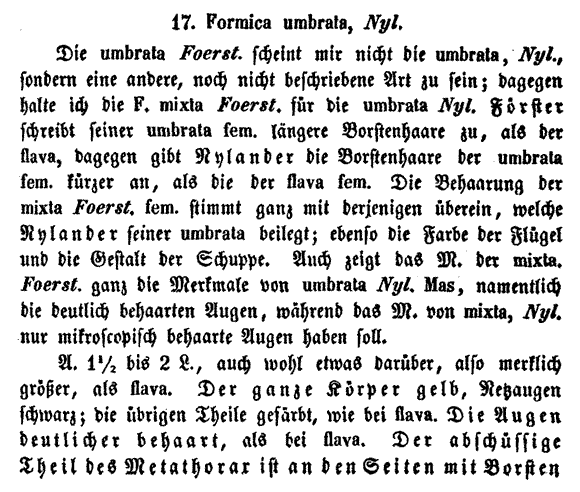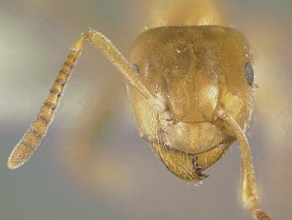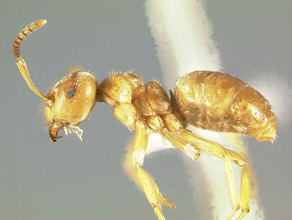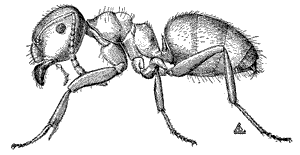- Identification
- Most of the body surface is covered with abundant, relatively short, silvery-yellow, predominantly erect hairs. All of the body and the appendages are densely covered with a short, whitish pubescence which is completely appressed on the body and appressed to decumbent on the appendages; on the gaster this is often dense enough to partly obscure the shining cuticular surface and to give the appearance of a whitish overcast, at least when seeging the workers with the naked eye. Lasius subumbratus is similar but has much longer hairs than umbratus.
- Biology
- Wilson (1955) reported on the biology of Lasius umbratus:
In Europe, according to Gosswald (1932), Zimmermann (1934), Donisthorpe (1927), and others, umbratus is less common than the prominent members of Lasius s. s. It prefers dry areas and rarely nests in moist soil; Skwarra (1929) found it very rare on the wet Zehlau moors of East Prussia. It usually nests under rocks, but also occurs in rotting wood (including the timbers of houses), at the foot of trees, or in open ground. On occasion it builds mounds. Its preferred habitat is woodland, but it has also been taken along forest borders and in cultivated fields. In North America, where no sibling comparable to rabaudi is yet known, umbratus differs from the European population in that it prefers moist soil, but it still shows the same latitude in specific nesting sites. The majority of colonies have been taken under stones, while the rest have been taken in or about rotting logs and stumps. I do not know of any case of this ant building mounds or even nesting in the open soil in North America, as it (or rabaudi) has been known to do in Europe. In the northern U. S. east of the Mississippi River, umbratus is limited mostly to moist woodland, where it occurs under a wide variety of conditions of soil texture and insolation. In Alabama and Florida, at the southern extremity of the range, all of the several colonies recorded were found in rotting logs and stumps in swampland. In the western U.S., all of the collections with ecological data that I have examined were made under rocks in open forest and along or near forest borders. In New Mexico, A. C. Cole took this species between 7100 and 8000 feet, always under rocks but under variable conditions of soil moisture and vegetation, e.g. dry soil with scattered juniper and pine or oak and pine, moist soil in a clearing near a hard wood forest, and moist soil in an open grassy area.
- additional biology notes...
- Distribution
- Range
- United States and Eurasia. Wilson (1953) - umbratus is widespread over both Eurasia and North America. Our present knowledge of its distribution in Eurasia is unfortunately limited due to its past erroneous identification with the cryptic species rabaudi and the present dearth of diagnostic characters in the worker. In eastern North America umbratus occurs from Nova Scotia south to the Gulf States. Westward, umbratus is abundant through North Dakota, as evidenced by the large numbers of collections made in many localities in that state by G. C. Wheeler and his students. It appears to be relatively common in the southern Rockies, but sparse to absent over most of the rest of western North America.
- Navajo Reservation Records
- Samples being processed.
- Additional Notes
- Western North America distribution
- Wilson (1955) - "There is a good possibility that its distribution west of the Great Plains is influenced in large part by competition from related species. It has never been taken within the range of L. vestitus, i.e. from northern California to British Columbia and northern Idaho. Moreover, in the mountainous areas where its range overlaps that of L. subumbratus, it tends to occur at lower elevations than that species and, so far as I know, the two have never been taken' in the same immediate locality."
- General Biology
- Wilson, 1955 (references contained within this passage can be found in the original publication):
In the face of the revelation that umbratus has a common and hitherto poorly known Palaearctic sibling, rabaudi (Bondroit) (= meridionalis Bondroit), the great mass of European literature pertaining to this species and its many synonyms cannot be accepted without major qualifications. It is in fact very probable that much of the literature deals with rabaudi instead of umbratus. Among the European authors, only Starcke (1937) seems to have fully realized the status and common occurrence of rabaudi and taken this taxonomic information into account in his ecological work. We are still very much in the dark as to whether the two species differ ecologically to any appreciable extent. In the following brief resume, reference to European literature on umbratus is made with the understanding that both species may be included.
As is the case in other species of Lasius, observations on the food habits of umbratus are entirely fragmentary and anecdotal. Umbratus is generally thought to be subterranean and to subsist primarily on the excreta of aphids and coccids, since these insects are often found in great numbers in the galleries with the ants (cf. Donisthorpe, 1927, and Gregg, 1944). However, in Holland, Starcke (1937) has observed workers foraging aboveground at night and carrying insects to the nests presumably for use as food. Brown (pers. commun.) has also observed workers aboveground on cloudy days in Pennsylvania.
A number of nuptial flights recorded by Donisthorpe (1927), Crawley (1915), and Eidmann (1926) suggest a long flight season in Europe, extending from as early as August 8 (Crawley) to as late as October 7 (Eidmann). However, there is again no way of knowing whether these records might not represent the overlapping periods of the two species umbratus and rabaudi. 'Winged queens, determined by me as authentic umbratus, have been taken in Europe on the following dates: IV-4, V-ll, VI-9, VI-12, VII-24, VII-3l, VIII, VIII, VIII- (15-20), VIII-22, VIII-28, IX- 3, IX-10, IX-13, IX-16, IX-17, IX-29; these do not involve any apparent geographic trend and by themselves may indicate an unusually long flight period.
The situation in North America is somewhat similar. I have observed queens in flight in the environs of Boston, Mass., in September during two recent seasons. Lone dealate queens were found wandering above ground at Cambridge, Mass., on September 5, 1952, and October 2, 1953, and at Plantagenet, Ontario, on June 30, 1952. Dates on which winged forms have been taken alone or in nido cover the same period, as shown by the following random sample: VI-2S, VII-S, VII-27, VIII-I, VIII-S, VIII-13, VIII-13, VIII-IS, VIII-20, VIII-3l, IX-I, IX-5, IX-9, IX-27, X-14, X-2S, X-29. Since there are no known sibling species to complicate the picture in North America, the data here suggest that on this continent at least umbratus has an unusually long nuptial season.
There is no evidence to indicate that the reproductives of umbratus build aerial swarms during their nuptial flights, as do those of niger and flavus, although this does not preclude the possibility. Eidmann (1926) observed queens of umbratus (or rabaudi?) flying singly in Germany, and I have observed definitely determined umbratus queens flying singly on two occasions in the Boston area.
Donisthorpe (1927), Crawley (in Donisthorpe, ibid.), Gosswald (1938), and Holldobler (1953) have reported in detail on the colony founding behavior of "umbratus" and "mixtus". The normal hosts are L. niger and L. alienus. Under both field and laboratory conditions dealate umbratus queens attack host workers as they encounter them away from the nests, seizing them up the mandibles and carrying them about as they resume foraging. Their victims are usually killed by this treatment and may eventually be eaten. With the fulfillment of this Mordinstinkt, as Holldobler calls it, and the presumed acquisition of the host odor, the queens are ready and able to enter host colonies, although they may be subjected to further attack before acquiring final acceptance. Unfortunately, the authors who have witnessed this phenomenon failed to make a convincing distinction between umbratus and rabaudi, and specimens were not saved to allow corroborative determinations during the present revision.
Niger and alienus probably serve as hosts of umbratus in North America as they do in Europe. I have seen two mixed niger-umbratus nest series from Ute Park, New Mexico (A. C. Cole leg. and CoIl., MCZ) and one alienus-umbratus series from Beatty, Pennsylvania (Schmitt leg.; MCZ). - Etymology
- Morphological. L. umbratus = shaded, shadowed, covered


- Literature
- Nylander, W. 1846. Additamentum adnotationum in monographiam formicarum borealium Europae. Acta Societatis Scientiarum Fennicae. 2:1041-1062.
- Wilson, E. O. 1955. A monographic revision of the ant genus Lasius. Bulletin of the Museum of Comparative Zoology at Harvard College. 113:1-201.
- A note about these publications. The literature cited here is not meant to be an exhaustive list of papers published about this species.
Page authored by David Lubertazzi and Gary Alpert



